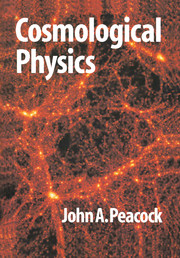Book contents
- Frontmatter
- Contents
- Preface
- Part 1 Gravitation and relativity
- Part 2 Classical cosmology
- Part 3 Basics of quantum fields
- Part 4 The early universe
- Part 5 Observational cosmology
- 12 Matter in the universe
- 13 Galaxies and their evolution
- 14 Active galaxies
- Part 6 Galaxy formation and clustering
- Hints for solution of the problems
- Bibliography and references
- Useful numbers and formulae
- Index
13 - Galaxies and their evolution
Published online by Cambridge University Press: 05 June 2012
- Frontmatter
- Contents
- Preface
- Part 1 Gravitation and relativity
- Part 2 Classical cosmology
- Part 3 Basics of quantum fields
- Part 4 The early universe
- Part 5 Observational cosmology
- 12 Matter in the universe
- 13 Galaxies and their evolution
- 14 Active galaxies
- Part 6 Galaxy formation and clustering
- Hints for solution of the problems
- Bibliography and references
- Useful numbers and formulae
- Index
Summary
The galaxy population
galaxy types For the optical astronomer, the most striking feature of the universe is the fact that stars appear in the discrete groups known as galaxies. There is no danger that the identification of galaxies is a subjective process akin to the grouping of stars in the Milky Way into constellations: the typical distances between galaxies are of order Mpc, and yet their characteristic sizes are a few kpc. Galaxies are thus concentrations of ≳ 108 times the mean stellar density. Why matter in the universe should be organised around such clear characteristic units is one of the most outstanding cosmological questions.
Galaxies come in several clear types, and it is a challenge to account for their distinct properties. At the crudest level, galaxies form a two-parameter family in which the characteristics that vary are the total amount of light and how this is divided between two components, the bulge and the disk.
(1) The bulge. This dominates the central portions of galaxies and is distinguished by its stellar populations and dynamics. The component is close to spherically symmetric and, although it rotates in general, it is supported against gravity primarily through stellar ‘pressure’: the bulge stars have a large radial component to their orbital velocities. The stars are population II: a set of stars that have aged sufficiently that short-lifetime stars more massive than the Sun have departed from the main sequence, leaving light that is dominated by the contribution of the giant branch.
[…]
- Type
- Chapter
- Information
- Cosmological Physics , pp. 387 - 418Publisher: Cambridge University PressPrint publication year: 1998



